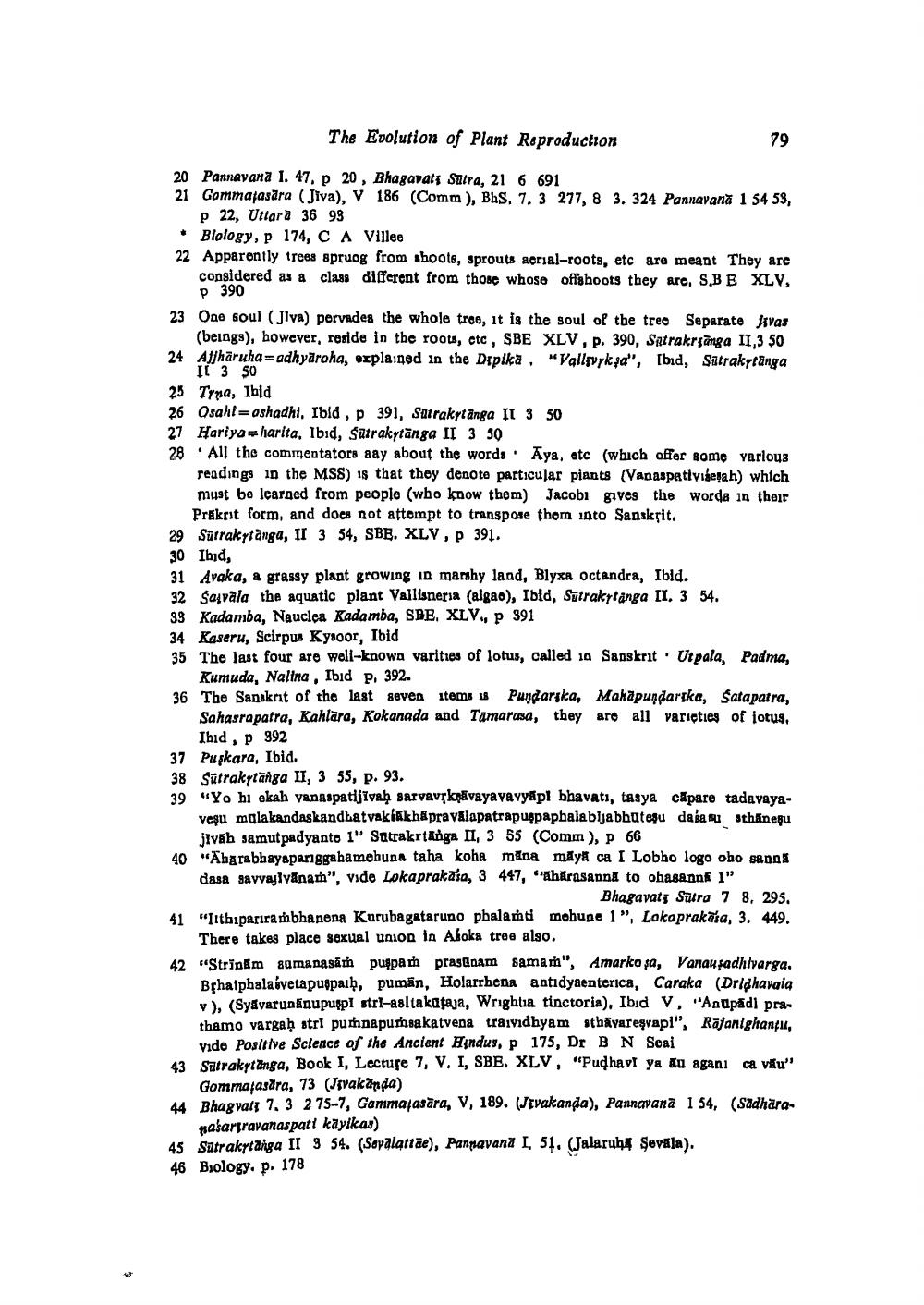________________
The Evolution of Plant Reproduction
20 Pannavana 1. 47, p 20, Bhagavatt Sutra, 21 6 691
21 Gommajasara (Jiva), V 186 (Comm ), BhS. 7. 3 277, 8 3. 324 Pannavană 1 54 53, P 22, Uttara 36 99
79
*
Biology, p 174, CA Villee
22 Apparently trees sprung from shoots, sprouts aerial-roots, etc are meant They are considered as a class different from those whose offshoots they are, S.BE XLV, P 390
23 One soul (Jlva) pervades the whole tree, it is the soul of the tree Separate vas (beings), however, reside in the roots, etc, SBE XLV, p. 390, Satrakranga II,3 50 24 Ajjharuha adhyāroka, explained in the Depika. "Valleykja", [bad, Satrakytinga II 3 50
25 Trna, Ibid
26 Osahl oshadhi, Ibid, p 391, Satrakytänga II 3 50
27 Harlya harita, Ibid, Satrakylänga II 3 50
28 All the commentators aay about the words Aya, etc (which offer some various
·
readings in the MSS) is that they denote particular plants (Vanaspativiserah) which must be learned from people (who know them) Jacobi gives the words in their Prakrit form, and does not attempt to transpose them into Sanskrit.
29 Sutrakytänga, II 3 54, SBE. XLV, p 391.
30 Ihid,
31 Avaka, a grassy plant growing in marshy land, Blyxa octandra, Ibid.
32 Savala the aquatic plant Vallisneria (algae), Ibid, Sutrakitanga II. 3 54.
33 Kadamba, Nauclea Kadamba, SBE, XLV., p 391
34 Kaseru, Scirpus Kysoor, Ibid
35 The last four are well-known varities of lotus, called in Sanskrit Utpala, Padma, Kumuda, Nalina, Ibid p. 392.
36 The Sanskrit of the last seven items is Pundarska, Makapuṇḍartka, Satapatra, Sahasrapatra, Kahlara, Kokanada and Tamarasa, they are all varieties of jotus, Ihid, p 392
37 Puşkara, Ibid.
38 Sutrakytänga II, 3 55, p. 93.
39 "Yo hi ekah vanaspatljivah sarvavṛkṇāvayavavyāpi bhavati, tasya căpare tadavayaveşu mülakandaskandhatvakikh pravilapatrapuspaphalabijabhuteşu dala su sthāneṣu jivah samutpadyante 1" Sutrakrtänga II, 3 55 (Comm), p 66
40 "Abarabhayaparıggahamehuna taha koha mina maya ca I Lobho logo oho sanna dasa savvajivanaṁh", vide Lokaprakasa, 3 447, "aharasanna to ohasanna 1"
Bhagavatz Sutra 7 8, 295.
41 "Ithiparırambhanena Kurubagataruno phalaṁti mohune 1", Lokaprakasa, 3. 449. There takes place sexual union in Akoka tree also.
42 "Strīpām aumanasaṁ puspaṁ prasanam samaṁ", Amarka şa, Vanauşadhivarga. Brhatphala vetapuspaiḥ, puman, Holarrhena antidyaenterica, Caraka (Dridhavaia v), (Syavarunanupuppi strl-asltakujaja, Wrightia tinctoria), Ibid V, "Anupadi prathamo vargaḥ strl puthaapumsakatvena tramvidhyam sthavaregrap", Rajanighans, vide Positive Science of the Ancient Hindus, p 175, Dr BN Seai
43 Sutrakytanga, Book I, Lecture 7, V. I, SBE. XLV, "Pudhavi ya au aganı ca vấu" Gommajasira, 73 (Jerakinda)
44 Bhagvatt 7. 3 275-7, Gammajasara, V, 189. (Jivakanja), Pannavanā 154, (Sadharasalartravanaspati käyikas)
45 Satrakrtanga II 3 54. (Sevalattae), Pannavana L 51. (Jalaruha Sevala).
46 Biology. p. 178




